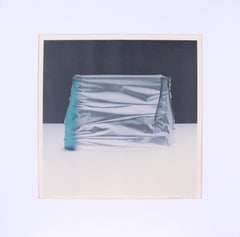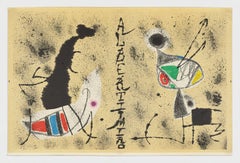Susumu ENDO Figurative Prints
Japanese, b. 1933
Walking into Endo Susumu’s house in the fashionable Jingumae district in Tokyo, one has the sense of visiting a friend in Scandinavia instead. Blond wood furniture is draped with colorful, geometric-patterned woolen throws and a profusion of plants brings nature into this urban residence. Endo has a long connection to that part of the world -- he has family in Finland, and he and his wife have made many trips there.
In fact, the physical geography of Finland and its shared aesthetics with Japan have inspired many of his photo- lithographs. Endo has written several books in Japanese about his technical process: taking photographs, downloading the images onto a computer where he manipulates the colors of the image, transferring the image to lithographic film and then printing these as lithographs.
Trained originally as a graphic designer, Endo started making lithographs in 1979. His early works depicted everyday objects like pencils, light bulbs, eggs, and bottles. In the mid 90s, a major change occurred in Endo’s choice of subject matter when nature became the element he most wanted to explore in his prints. He never divulges the exact location of his photographs, simply remarking with a mischievous smile that they are taken in Japan or Finland.
He says that his work is all about constructing a world where the real and unreal coexist and interact. Endo says that he thinks in a non-digital, analog way, but is always eager to take advantage of the latest technology for his creations.
Last year, at a party in Tokyo at my father's, we talked about the quality of light in his work. Endo says he tries to use light as a way to layer different timelines. I look at his work and feel that I am peering into a dream world, and the artist is totally fine with that, adding “most of my work since the 1990s is from the Space and Nature series, so light is important as a way to illuminate what you are seeing in space and nature.”
Read more about Endo-san: https://www.thetolmancollectionofnewyork.com/post/the-serene-prints-of-susumu-endoto
1
1
Overall Width
to
Overall Height
to
1
1
834
373
349
308
1
1
1
1
1
1
1
1
1
Artist: Susumu ENDO
"Space And Space" - 1988 Offset Lithograph on Paper
By Susumu ENDO
Located in Soquel, CA
"Space And Space" - 1988 Offset Lithograph on Paper
Offset lithograph titled "Space and Space" by Susumu Endo (Japanese, B- 1933). Two bottles are depicte...
Category
1980s Impressionist Susumu ENDO Figurative Prints
Materials
Paper, Ink, Lithograph
$1,480 Sale Price
20% Off
Related Items
Spanish artist original 1975 lithograph on canvas book cover for Rafael Alberti
By Joan Miró
Located in Miami, FL
Joan Miro (Spain, 1893-1983)
'Maravillas con variaciones acrósticas en el jardín de Miró (cobertura para el estuche)', 1975
lithograph on canvas
21.5 x 32.25 x 21 in. (54 x 82 cm.)
Edition of 1500
Unframed
ID: MIR2001-014
It is documented in Cramer, P (1992). Miró Litographer V (1972-1975). Maeght Éditeur, pp 162-163. No. 1051.
Artwork history:
At the end of 1971 Rafael Alberti wrote from Rome to Joan Miró in the following terms “(…) I think I have news that you liked my folder...
Category
1970s Abstract Susumu ENDO Figurative Prints
Materials
Lithograph, Canvas, Ink
$800
H 21.25 in W 32.28 in
Parade (Surrealist Black Philadelphia Artist)
By Roland Ayers
Located in Wilton Manors, FL
Roland Ayers (1932-2014).
Parade, 1960
Drypoint Etching, 5.5 × 17.75 inches.
Signed, titled and dated by the artist in pencil, lower margin.
Small tear, left margin which exte...
Category
1960s Surrealist Susumu ENDO Figurative Prints
Materials
Paper, Ink
Apple, Lt Ed St. Louis Art museum print Signed & dated by Roy Lichtenstein Frame
By Roy Lichtenstein
Located in New York, NY
Roy Lichtenstein 1970-1980 (Hand Signed and dated by Roy Lichtenstein), 1981
Offset lithograph. Hand signed and dated in ink
Hand-signed by artist, H...
Category
1980s Pop Art Susumu ENDO Figurative Prints
Materials
Ink, Lithograph, Offset, Pencil, Graphite
$8,800
H 37 in W 27 in D 0.5 in
Empirial Message (Surrealist Black Philadelphia Artist)
By Roland Ayers
Located in Wilton Manors, FL
Roland Ayers (1932-2014).
The Emperial Message, 1959.
Drypoint Etching on paper, 15 × 17 ¾ inches. Larger in acid free archival matting. No Frame.
A/P (no edition, unique examp...
Category
1960s Surrealist Susumu ENDO Figurative Prints
Materials
Paper, Ink
Hockney's Alphabet, portfolio of 26 lithographs signed by Hockney and 23 writers
By David Hockney
Located in New York, NY
David Hockney
Hockney's Alphabet, 1991
26 color lithographs in Fine Art Cartridge paper bound in quarter vellum with handmade Fabriano Roma paper sides, housed in matching box; signed by David Hockney and most contributors in ink and numbered 178 in black ink on the justification page
Numbered 178/250
Hand signed by 24 of the contributors, including David Hockney and Steven Spender
12 5/8 x 9 5/8 inches
Bound in book and held in slipcase
This portfolio features 26 color lithographs in Fine Art Cartridge paper with full margins, bound as issued, in quarter vellum with handmade Fabriano Roma paper sides, in original grey slipcase. It is signed by David Hockney (the artist) and most contributors in ink and numbered 178 in black ink on the justification page, from the edition of 250, with full text and title page, published by Faber & Faber, London, text edits by Stephen Spender, who also signed.
It is illustrated by David Hockney, hand signed by David Hockney and Stephen Spender and also signed by the following contributors: Douglas Adams, Martin Amis, Julian Barnes, William Boyd, Margaret Drabble, Patrick Leigh Fermor, William Golding, Seamus Heaney...
Category
1990s Pop Art Susumu ENDO Figurative Prints
Materials
Ink, Mixed Media, Vellum, Lithograph, Board, Pencil, Offset
$14,500
H 12.63 in W 9.63 in D 1.5 in
Batman and Robin offset lithograph card (hand signed by Mel Ramos) ex-UACC pres.
By Mel Ramos
Located in New York, NY
Mel Ramos
Batman and Robin (Hand signed Postcard), ca. 1991
Offset Lithograph on Card
Hand signed by the artist on the lower front
Held in original v...
Category
1990s Pop Art Susumu ENDO Figurative Prints
Materials
Postcard, Offset, Ink
$800
H 10.5 in W 9 in D 0.25 in
La Bonne faisant son Marché
By Camille Pissarro
Located in New York, NY
A superb, richly-inked impression of this scarce drypoint printed in dark brownish black on cream laid paper. Second state (of 4), with the drypoint work on the windows upper right. ...
Category
1880s Impressionist Susumu ENDO Figurative Prints
Materials
Laid Paper, Drypoint
Galerie Mikro Berlin rare European Pop Art print, Hand Signed by Jim Dine, Frame
By Jim Dine
Located in New York, NY
Jim Dine
Complete Graphics poster (hand signed by Jim Dine), 1970
Offset lithograph poster (hand signed by Jim Dine)
39 1/2 × 26 inches
Frame included: held in the original vintage m...
Category
1970s Pop Art Susumu ENDO Figurative Prints
Materials
Ink, Lithograph, Offset
$2,500
H 39.5 in W 26.5 in D 0.5 in
The Broad Curtain
By Childe Hassam
Located in New York, NY
A superb, richly-inked impression of this very scarce lithotint on Japan paper. Edition of approximately 55. Signed with the artist's cypher in pencil, lower right.
Category
1910s American Impressionist Susumu ENDO Figurative Prints
Materials
Lithograph
Une Mère et Deux Enfants
By Pierre-Auguste Renoir
Located in New York, NY
A very good, dark and evenly-printed impression of this scarce lithograph on cream laid paper. From the edition of approximately 50.
Category
1910s Impressionist Susumu ENDO Figurative Prints
Materials
Laid Paper, Lithograph
"Open Wide" 1972 original signed engraving lithograph limited edition American
Located in Miami, FL
Robert Smith (United States, 1944)
'Open wide', 1972
lithograph in color on paper
21.7 x 29.6 in. (55 x 75 cm.)
Edition of 75
Unframed
ID: SMI1158-001-075
Hand-signed by author
Category
1970s Contemporary Susumu ENDO Figurative Prints
Materials
Paper, Ink, Lithograph, Engraving, Etching, Aquatint
Monograph, Hand Signed by Francesco Clemente and inscribed with a small drawing
By Francesco Clemente
Located in New York, NY
Francesco Clemente
Clemente (Hand Signed by Francesco Clemente and inscribed with a small drawing), 1998
Large Illustrated Softback Exhibition Catalogue. (Hand signed and inscribed t...
Category
1990s Contemporary Susumu ENDO Figurative Prints
Materials
Paper, Ink, Mixed Media, Lithograph, Offset
$880
H 11.7 in W 10 in D 2 in
Susumu Endo figurative prints for sale on 1stDibs.
Find a wide variety of authentic Susumu ENDO figurative prints available for sale on 1stDibs. You can also browse by medium to find art by Susumu ENDO in ink, lithograph, paper and more. Much of the original work by this artist or collective was created during the 1980s and is mostly associated with the Impressionist style. Not every interior allows for large Susumu ENDO figurative prints, so small editions measuring 28 inches across are available. Susumu ENDO figurative prints prices can differ depending upon medium, time period and other attributes. On 1stDibs, the price for these items starts at $1,850 and tops out at $1,850, while the average work can sell for $1,850.

